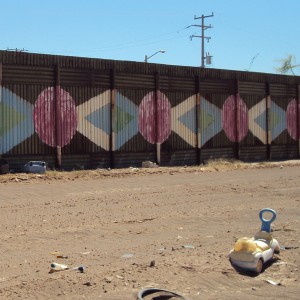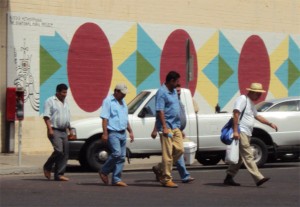
A child’s discarded push car toy lies among the empty bottles, televisions, tires and other debris in front of the two-mile mural painted on the international border fence separating Calexico and Mexicali. There are no plans to repaint the mural as it begins to fade. --Photo by Stacy Garcia
CALEXICO, Calif.–This bustling border town in Southern California’s Imperial Valley was quite different in the 1960s than it is today. People filing through the international port of entry merely had to state where they were born in order to enter the U.S. Port vehicle traffic flowed in just two lanes rather than snaking through the 12 they have today. The friendship between Calexico and its sister city, Mexicali, on the Mexican side was so casual, kids in both countries could share what could be called a bi-national game of baseball.
But, more than a decade ago a solid brown metal fence was erected as part of Operation Gatekeeper, President Clinton’s answer to stem the tide of illegal immigration from Mexico into the U.S. between California and Texas.
“When this fence went up, the ability to perceive and to sense this community, this trans-border community all of a sudden became harder because you couldn’t see across the fence anymore, and so both sides of the border expressed outrage,” Herrera said.

Carlos Herrera, history professor at San Diego State University’s Calexico campus, recalls the friendship he had as a child with his counterparts across the border in Mexicali. Herrera was one of the organizers of the Binational Mural painted on the fence almost 10 years ago. --Photo by Stacy Garcia
Herrera, a history professor at the San Diego State University Calexico campus, was among a small group of citizens who felt saddled by the offending fence, but did not feel they had to settle on its appearance, so they set to work on making it more aesthetically appealing.
In 1998, the Calexico Arts Commission quickly established the Border Metamorphosis-Binational Mural Project to raise about $60,000 from public and private sources, commissioning internationally renowned conceptual artist and Calexico native Armando Rascon to create an artistically meaningful message to be emblazoned on two miles of the American side of the fence. Rascon designed an image that represented the beliefs of one of Mexico’s oldest civilizations—the Olmec people.
“It symbolizes the Olmec, who believed that the world is perceived through sight, touch and sound, so the idea here is communication,” Rascon said in a telephone interview from his studio in Washington, D.C. The two-mile-long mural depicts what the ancient Olmec used in their “friendship bracelet,” a series of geometric figures with a central orb, or an “all-seeing eye,” Rascon said.
More than 2,400 people from the Imperial Valley helped paint the mural on the dull, brown fence from 1998 to 2001. “Some people came as far as Australia to do a few brush strokes on the mural,” Herrera said.

Rene Miranda, a volunteer who helped paint the Border Metamorphosis: Binational Mural along the Calexico-Mexicali border fence as a high school student, is now a microbiologist for a nutraceutical company in San Diego. --Photo by Stacy Garcia
Busloads full of high school students would arrive on site every Friday throughout the project to help paint the mural. Among them was Rene Miranda, now a microbiologist in San Diego. “I didn’t think much about what I was doing,” Miranda said. “But now with all that is happening in Arizona, I reflect on the actions we, my classmates, were doing and I see how important it is to unite for the sake of our community.”
The “friendship bracelet,” however, has not replaced a certain camaraderie felt between kids on both sides of the border, who were able to see, talk to and tease each other through only a chain-link fence that separated them decades ago.
As a child Herrera and his buddies would play baseball in vacant lots next to the border. “To hit a homerun you had to hit the baseball over the fence into Mexicali,” he said. But even friendship had its price at the time. “It was very difficult to get the ball back,” he laughed. “A lot of times there were kids our age on the Mexicali side, just sitting on the sidewalk just watching us play baseball, and they would give us back the ball if we gave them a quarter, so we always had to have a couple of quarters.”
Today, a visitor even approaching the border fence is stopped and questioned by border agents. The vacant lots no longer host baseball games, but instead have become a wasteland for discarded toys, bottles, electronics, tires and other debris.
After 10 years of three-digit summer temperatures and mercilessly constant hot winds, the friendship mural is rotting away. Rust smears the precise lines of the art. Mexicali residents burning their waste right behind the mural, on the Mexican side of the fence, also melt and distort the mural’s paint, according to Herrera.

A replica of the Border Metamorphosis: Binational Mural is painted on the wall of a store in downtown Calexico. The store owner and the city of Calexico have promised to repaint the replica mural to keep alive the message of the original but fading mural on the border fence. --Photo by Stacy Garcia
And, there is no plan or future funding to keep the mural intact and alive, as it erodes. But, then, that’s not what was planned.
“This mural is not intended to be preserved forever,” said artist Rascon. “It was a moment in time that was intended to send a message and to reinforce the idea that border towns, even though they are separated by an artificial barrier, are not separate, they are very much tied to each other.”
If that message is still clear, Rascon explained, then efforts to restore the mural will be vigorous, like they were a decade ago. Otherwise, they will fade, just like the mural is fading.
A replica of the two-mile mural is painted on the side of a downtown Calexico store at Heffernan and 2nd Streets in Calexico as a small reminder of the larger mural’s message. That building, unlike others of the same age in historic downtown Calexico, survived the 7.2 Easter Sunday earthquake that devastated parts of the Baja and Southern California border region. But the future of the Binational Mural might not survive harsher elements, like the interest of the people.


Well done, Stacy!
Some nice history of the calexico/Mexicali area here. Thanks!
We should make an effort to restore this mural. In a few years there will be a new border crossing and outlet mall in that area where fence will be at the forefront of many border crossers and shoppers.
Stacy….. am I reading the New York Post ??? hahahah niceeeeeee work =)…. idk if my english retarded props help :P. but keep it up…
Cool story that tells about another aspect of the border divide. Art can and does tear down walls. Keep writing Stacy.
MEE GUSTOO ME GUSTOO U.U
BUEN TRABAJO STACYY:)
You did such a good job on this, I love it!
Nice pictures! I like the photograph you got of Renee. It makes your story dynamic : )
Looking for my old friend Armando Rascon. Any leads?